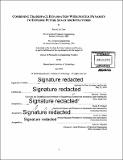Combining tradespace exploration with system dynamics to explore future space architectures
Author(s)
La Tour, Paul A. (Paul Alexis)
DownloadFull printable version (103.8Mb)
Other Contributors
Massachusetts Institute of Technology. Engineering Systems Division.
Advisor
Daniel E. Hastings.
Terms of use
Metadata
Show full item recordAbstract
This work proposes a merger of Tradespace Exploration with System Dynamics modeling techniques in a complementary approach. It tests the value of this mixed method for modeling the multiplicity of inputs and complexity of feedback loops that affect the cost, schedule and performance of satellite constellations within the Department of Defense. The resulting simulation enables direct comparison of the effect of changing architectural design points and policy choices with respect to satellite acquisitions and fielding. A generation-over-generation examination of policy choices is made possible through the application of soft systems modeling of experience and learning effects. The resulting model enables examination of possible futures given variations in assumptions about both internal and external forces on a satellite production pipeline. This thesis performs a policy analysis examining the current path of the Global Positioning System acquisition and compares it to equivalent position navigation and timing capability delivered through a variety of disaggregated options while varying: design lives, production quantities, non-recurring engineering and time between generations. The extensibility of this technique is investigated by adapting the model to the mission area of Weather and Climate Sensing. This thesis then performs a policy analysis examining different disaggregated approaches for the Joint Polar Satellite, focusing on the impact of complexity. Discussion of factors such as design choices, context variables, tuning variables, model execution and construction is also included.
Description
Thesis: Ph. D. in Engineering Systems, Massachusetts Institute of Technology, School of Engineering, Institute for Data, Systems, and Society, 2016. Some pages printed landscape orientation. Cataloged from PDF version of thesis. Includes bibliographical references (pages 342-351).
Date issued
2016Department
Massachusetts Institute of Technology. Engineering Systems Division; Massachusetts Institute of Technology. Institute for Data, Systems, and SocietyPublisher
Massachusetts Institute of Technology
Keywords
Institute for Data, Systems, and Society., Engineering Systems Division.